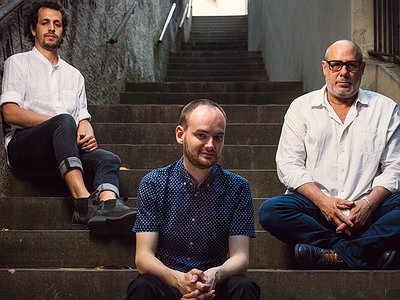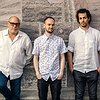Part 1
Name: Silvan Joray
Occupation: Guitarist, composer, improviser
Nationality: Swiss
Current release: Silvan Joray's new album Updraft is out Ubuntu.
Recommendations: I’d like to recommend the album Sincerity by Andy Herrmann, a German pianist. It features Mike Moreno on guitar, Arne Huber on bass and Jochen Rückert on drums. I love the compositions and the playing and have been listening to it a lot lately.
Another gem is Wolfgang Muthspiel’s album Rising Grace from 2016 that features a stellar line-up with Ambrose Akinmusire, Brad Mehldau, Larry Grenadier and Brian Blade. There are some extraordinary (group) improvisations on that record.
[Read our Jochen Rückert interview]
[Read our Jochen Rückert interview about Technology and Artificial Intelligence]
[Read our Wolfgang Muthspiel interview]
If you enjoyed this Silvan Joray interview and would like to stay up to date on his music and current live dates, visit his official homepage. He is also on Instagram, and Facebook.
Do you think that some of your earliest musical experiences planted a seed for your interest in improvisation?
I started out on ukulele and then classical guitar and my initial plan was to become a classical guitarist. At the time I was also playing drums and it wasn’t until a few years after I had started, that my dad took me to a jazz club in Bern.
We saw a concert by pianist Hiromi and I absolutely loved her music and was listening to her CD Brain all the time. But at that point I wasn’t really aware that most of what I was hearing was improvised. I had been told so but it was hardly conceivable. I guess you could say that a seed was planted at that point.
[Read our Hiromi interview]
When did you first consciously start getting interested in musical improvisation? Which artists, teachers, albums or performances involving prominent use of improvisation captured your imagination in the beginning?
I first started improvising on drums in high school and played in a workshop band (mostly funk and a little bit of jazz). Improvising on guitar and playing chords still felt very intimidating, as I was used to playing classical pieces.
At some point, my timetable changed and they had to get a new drummer. All my friends were playing in that band and I really wanted to rejoin the next semester. Luckily the drum chair was already taken though, and I had to start playing electric guitar, improvise, and learn about chords in order to be able to rejoin the band. So I kind of got into it by just doing it and trying, instead of hearing a record that I really liked.
In fact, even though at this point I was saying that I wanted to be a jazz guitarist, I still didn’t really know anything about the history of jazz guitar or jazz in general. Then my dad started teasing me: “How is it possible that you want to be a jazz guitarist but you don’t even listen to any jazz guitarists?“ That got me thinking and so I started exploring.
At first I was more into smooth jazz like the album Fingerprints by Larry Carlton.
But soon I found pleasure in listening to Wes Montgomery’s album Smokin’ at the Half Note.
When it was time to decide which school to attend for my bachelor studies, I discovered Wolfgang Muthspiel, who was teaching at Jazzcampus Basel. He had recently released his first ECM record as a leader called Driftwood and I got really into it.
I ended up studying in Basel with Wolfgang, and he strongly shaped my musical understanding and helped me form my musical taste. He encouraged me to write my own music and even joined me in the studio as artistic producer when I was recording my first album cluster.
Wolfgang taught me to always focus on the vibe, to take care of my sound and the band sound as a whole.
Tell me about your instrument and/or tools, please. What made you seek it out, what makes it “your” instrument, and what are some of the most important aspects of playing it?
In terms of guitar in general, I got introduced to it naturally because my mother is a guitar teacher and I was exposed to the sound of it already when I was still in the womb.
In terms of the specific instruments, I have two amazing guitars by German luthier Stefan Schottmüller. I initially sought him out because I was a big fan of Norwegian guitarist Lage Lund who was playing one of his guitars. Another reason was that his arch top guitars are short-scale, meaning a slightly shorter fretboard. Since I had been dealing with some tendonitis issues in 2017/2018, I was hoping that this would help me play some voicings with less effort.
So I got Schottmüller’s small archtop which was my main guitar until about 2020. It has a beautiful acoustic sound and I used it to record my first album cluster. We used a microphone in front of the guitar to capture the acoustic sound. This can be heard on “See You in June“ or any other track of the album.
After that, I recorded for my friend Sebastián de Urquiza’s albums Unity Vol. 1 and Unity Vol. 2 and needed to use distortion sounds.
Since my archtop wasn’t really suitable for that, I talked to Schottmüller about getting one of his semi-hollow models. These are usually normal scale but he also had two short-scale versions of it and I ended up getting one of them. I wanted both guitars to have the same scale length, so I could effortlessly switch between them.
When I started experimenting with the tapping technique, I started favoring the semi-hollow model because it is easier to make the tapped notes come out. Also legato playing and bending (for quarter tones) works better.
These days I’m almost exclusively playing the semi-hollow and recorded my latest album Updraft with it.
How would you describe your own relationship with your instrument – is it an extension of your self/body, a partner and companion, a creative catalyst, a challenge to be overcome, something else entirely?
I see my guitar as a means to express my imagination, the melodies I’m hearing. So in a way yes, I would say it is an extension of myself.
I had been practicing a lot of ear training and scatting early on, so it has always been the goal to be able to let my ideas come out through the instrument and not let my muscle memory decide what I’m going to play.
Derek Bailey defined improvising as the search for material which is endlessly transformable. What kind of materials have turned to be particularly transformable and stimulating for you?
I really enjoy playing intervals or small voicings of three notes because it gives me a lot of freedom to move the voices around and also apply them over different chords. If you play an interval and change one of the notes and let the other ring, you end up with a different interval. There are endless possibilities in the counterpoint between two notes.
I use a lot of sixths, sevenths, and seconds in my playing. “At Long Last Love“, the last track of my new album, is a good example of my usage of intervals and small voicings to comp for myself, especially in the head.
Furthermore, the ending part of the track features an extensive tapping section, a technique that I have been exploring and that gives me a lot of transformable material.
I have also been experimenting with quarter tones, meaning dividing the interval of a minor second in half. I’m exploring the endless melodic possibilities that this opens up and enjoy finding new ways of using those microtonal connections between two “regular“ notes.
This is something I still have to dig much deeper into but it can be heard in some moments on the new album, for example towards the end of my solo on “Kokodrillo“ (around 4:30).
Do you feel as though there are at least elements of composition and improvisation which are entirely unique to each? Based on your own work or maybe performances or recordings by other artists, do you feel that there are results which could only have happened through one of them?
Yes, definitely! The process is similar in a way, but I think that the unique element of composition is the time that we’re able to spend exploring and changing (the same) details over and over again.
When composing, I am the only decision maker and can come up with harmonic progressions in a way that I can’t when improvising. In improvisation – unless one plays solo – there are usually other people around with whom there is an agreement on a specific progression (usually an existing progression of a composition) or who are also trying to steer the harmony in a specific direction that they’re hearing (if it’s freely improvised).
This is the element that I think is unique in improvisation, the creation in the moment and the perishability of it. If something is improvised, you can be sure that what you’re hearing will never happen again in the exact same way. In terms of results, I think the combination of both improvised and composed pieces is very interesting. Both on my first album cluster, and on my new album Updraft there are some improvised pieces that function as transitions between compositions.
For the Updraft recording session, we actually recorded almost an hour worth of freely improvised material from which two short pieces “Morning Breeze“ and “Evening Breeze“ ended up on the album. Bass player Nadav doesn’t play on the first one, but on the latter we are creating the harmonic progression together in the moment.
On “Space 7“ from the album cluster you can witness a magical moment of what feels almost like telepathy when the drummer and I enter with the same quarter note pulse exactly at the same time and the groove changes.
Also “Space 12” is freely improvised and features a harmonic progression that Nadav and I are making up in the moment.
These free interludes give the album a more open touch that in my opinion couldn’t be achieved solely with compositions.
I love the album Stompin’ off Greenwood by American saxophonist Greg Ward where he uses the same concept of free group improvisations between compositions.






